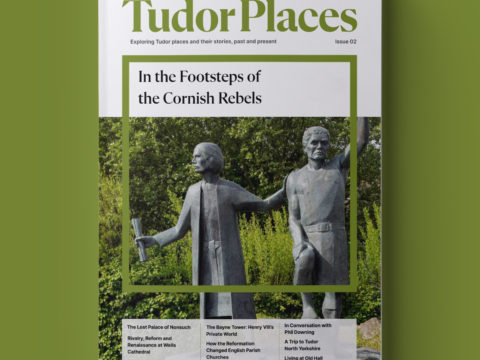Mary, Queen of Scots: Life Story
Chapter 16 : Murder
Mary dismissed the rumours and warnings she now received, and proceeded to open Parliament, requesting an act of attainder be passed against Moray. The proposed act was to be debated on 12th March 1566. This precipitated the rebels’ action. That night, whilst Mary was having supper with her half-sister, the Countess of Argyll, her half-brother, Lord Robert Stewart, and a few others, including Riccio, her husband entered the room.
Moments later, Patrick, Lord Ruthven, burst in, dressed in armour and requested that Riccio go with him, as he had been in Mary’s privy chamber ‘overlong’. Mary replied that Riccio was her servant, there at her invitation. The scene quickly degenerated. Mary was grabbed by her husband and held captive, whilst the conspirators burst into her rooms at Holyrood.
Mary was seized by her husband, and one of the conspirators pointed a pistol at her pregnant belly. Riccio was dragged out and stabbed multiple times, with King Henry’s dagger used to implicate him in the murder.
Bothwell and Huntly had escaped during the fracas, but Mary was now in a palace controlled by her enemies, with the once-banished Moray already en route from Newcastle. Mary was left overnight, with no-one but Lady Huntly (widow of the earl who had rebelled against her). Lady Huntly had obviously taken her husband’s death as the fortune of war, as when Ruthven sent her away the next day, she had a letter from Mary for the Earl of Huntly hidden in her clothes.
Mary quickly planned her strategy. Her husband was the weak point in the conspirators’ plans, and the next morning, she managed to persuade him that his life, as well as hers was in danger, and together they hatched an escape plan. The first element was Mary’s pretence to Ruthven that she would grant him and the others royal pardon. Shortly after, Moray appeared. Mary did not seem to realise that he could only have arrived so promptly if he had been involved in the plot, and rushed into his arms, protesting that, had he been there, she would not have been so mistreated.
Shortly after, she claimed to feel labour-pangs beginning, and the midwife the conspirators had sent for confirmed the queen was in a dangerous state. Later that night, she and her husband slipped out of the palace, and taking horses that had been prepared for them by three of the household whom she had persuaded to help her, rode the twenty-five miles to Dunbar Castle. When Mary struggled with the furious pace, her husband told her that it did not matter if she lost the baby – they could make another.
From Dunbar, Mary was able to appeal to her loyal lords, and within two weeks she was back in Edinburgh, apparently safe on her throne, with the rebels scattered. Moray was back by her side – his part in the plot unknown to his half-sister.
Mary also had to put as good a face as possible on her relationship with her husband. There must be no talk of annulment, lest it damage the legitimacy of her child, but, although she could not discard him, there was now no possibility of him extending his power. Her main advisers were once again Moray, Argyll, Glencairn, Bothwell (all Protestants), Huntly and Atholl (Catholics).
In June 1566, she retired to Edinburgh Castle, where she gave birth, after a hard labour, to a son, whom she named James. She had thus fulfilled her most important role as a monarch – providing an heir, and a male one. Her own health suffered severely, and she did not recover for months, or even years.
James was baptised as a Catholic at Stirling Castle, with enormous pomp – the only occasion during her personal reign when Mary raised taxation. Elizabeth sent the Earl of Bedford with gifts, and the Countess of Argyll stood as her proxy as godmother. A few months later, he was sent to Stirling, where the Earl of Mar had care of him, in accordance with tradition.
King Henry was now considered of little account, whilst the Earl of Bothwell, buoyed up by having the queen’s political favour (there is no evidence of any personal relationship at this time) was now as unpopular as Riccio had been.
Mary, Queen of Scots
Family Tree
